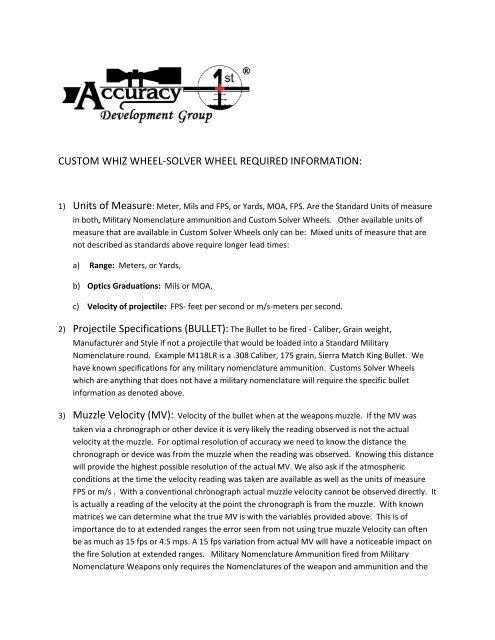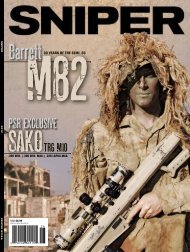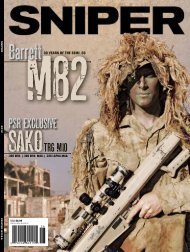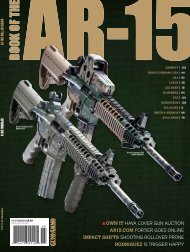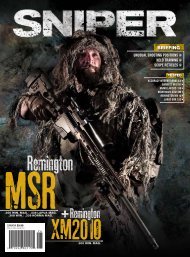Solver Wheel Ordering Criteria (PDF) - Accuracy 1st
Solver Wheel Ordering Criteria (PDF) - Accuracy 1st
Solver Wheel Ordering Criteria (PDF) - Accuracy 1st
Create successful ePaper yourself
Turn your PDF publications into a flip-book with our unique Google optimized e-Paper software.
CUSTOM WHIZ WHEEL‐SOLVER WHEEL REQUIRED INFORMATION:1) Units of Measure: Meter, Mils and FPS, or Yards, MOA, FPS. Are the Standard Units of measurein both, Military Nomenclature ammunition and Custom <strong>Solver</strong> <strong>Wheel</strong>s. Other available units ofmeasure that are available in Custom <strong>Solver</strong> <strong>Wheel</strong>s only can be: Mixed units of measure that arenot described as standards above require longer lead times:a) Range: Meters, or Yards,b) Optics Graduations: Mils or MOA,c) Velocity of projectile: FPS‐ feet per second or m/s‐meters per second.2) Projectile Specifications (BULLET): The Bullet to be fired ‐ Caliber, Grain weight,Manufacturer and Style if not a projectile that would be loaded into a Standard MilitaryNomenclature round. Example M118LR is a .308 Caliber, 175 grain, Sierra Match King Bullet. Wehave known specifications for any military nomenclature ammunition. Customs <strong>Solver</strong> <strong>Wheel</strong>swhich are anything that does not have a military nomenclature will require the specific bulletinformation as denoted above.3) Muzzle Velocity (MV): Velocity of the bullet when at the weapons muzzle. If the MV wastaken via a chronograph or other device it is very likely the reading observed is not the actualvelocity at the muzzle. For optimal resolution of accuracy we need to know the distance thechronograph or device was from the muzzle when the reading was observed. Knowing this distancewill provide the highest possible resolution of the actual MV. We also ask if the atmosphericconditions at the time the velocity reading was taken are available as well as the units of measureFPS or m/s . With a conventional chronograph actual muzzle velocity cannot be observed directly. Itis actually a reading of the velocity at the point the chronograph is from the muzzle. With knownmatrices we can determine what the true MV is with the variables provided above. This is ofimportance do to at extended ranges the error seen from not using true muzzle Velocity can oftenbe as much as 15 fps or 4.5 mps. A 15 fps variation from actual MV will have a noticeable impact onthe fire Solution at extended ranges. Military Nomenclature Ammunition fired from MilitaryNomenclature Weapons only requires the Nomenclatures of the weapon and ammunition and the
actual barrel length and we will have the actual MV ranges it will be operating within. If the true MVis not known but a velocity was observed from a chronograph or other device, this normally will stillprovide enough information for a solver wheel to be produced with minimal error but for extremeaccuracy of the fire solution the solver wheels have a +/‐ 50 fps or 15.4 mps truing capability builtinto every solver wheel. This contingency MV variation, whether it is due to inputting incorrect trueMV or from MV variations due to ammunition lot variations can be trued. Truing negates thesevariations when performed correctly “see instruction manual”. Once the solver wheel is trued evenwith the noted variations the fire solution will have a resolution of +/‐ 0.1 mrad or 0.25 moa for thefull extents of the ranges denoted by the solver wheel.4) Sight Height (SH): Which is the Distance from the Center of the scope to the center of the riflebarrel bore. It can be provided in inches or millimeters. Again most Military Nomenclatureweapons have a fixed Sight Height which we will have databases for. We still request that thisinformation be provided to insure our solver wheel will be perfectly matched to your weaponssystem. Even if a particular solver wheel does not perfectly match any given weapons systems sightheight, a correction factor can be applied to actually true the variation. The correction factor is: forevery 0.5” or 12.7 mm the sight height is above the solver wheel denoted SH, 0.1 mil or 0.344 moashould be added to the final fire solution hold. If the weapons actual SH is under the wheel denotedSH, the corrected fire solution is minus the 0.1 mils or 0.344 moa for every 0.5” or 12.7mm.5) Twist Rate of Barrel (TR): If unknown and the weapons has factory unaltered barrel or is amilitary nomenclature unaltered weapon, we can look the twist rate up within our databases. Againmilitary nomenclature weapons will have known TR, but often custom modifications have beenmade to specific special operations sniper weapons that will affect MV, SH and TR. We will alwaysask the twist rate and barrel length to insure the highest level of accuracy is achieved. TR and MVare directly tied to the spin drift correction. Which for close range is of minor concern but atextended ranges spin drift must be accounted for in order to achieve an accurate fire solution.The program that generates the graphical solution that is used to solve for a fire solution in the Whiz<strong>Wheel</strong> is a complex program containing a modified point mass solver written by Bryan Litz. Our programas well as any ballistic solver is constrained to the quality of the fire solutions being controlled by thequality of the inputs or GIGO. (Garbage IN results in Garbage Out). So when being asked the abovequestions please keep in mind their resolution highly impacts the results that will be achieved. Tonegate the influence of the resolution of the inputs the truing option as described in the instructionmanual can correct the variation of the inputs within the MV limits of +/‐ 50 FPS or 15.4 MPS and anyweapons variation resulting in increased or lessened drag of the projectile. Again once trued for anyobserved variation your Whiz <strong>Wheel</strong>s fire solution will be well within the resolution of the weaponssystem accuracy limits.


